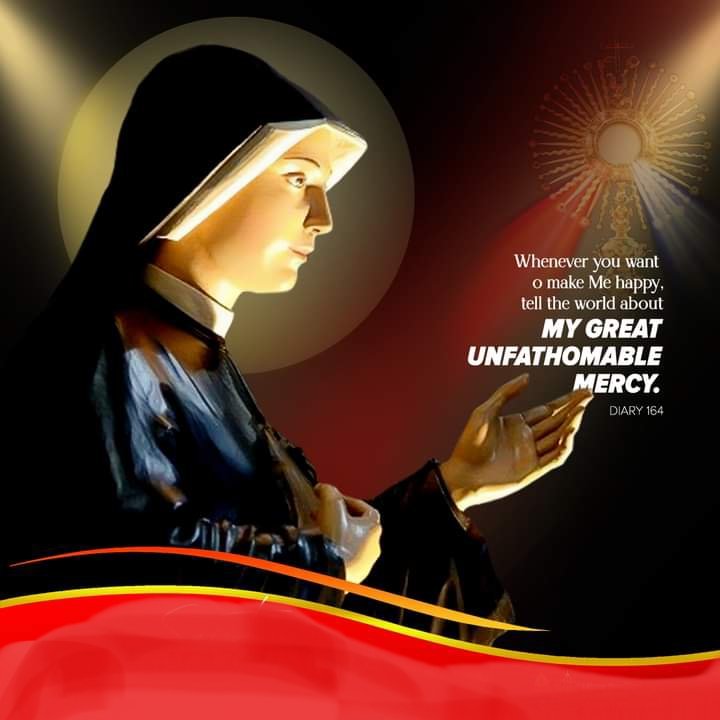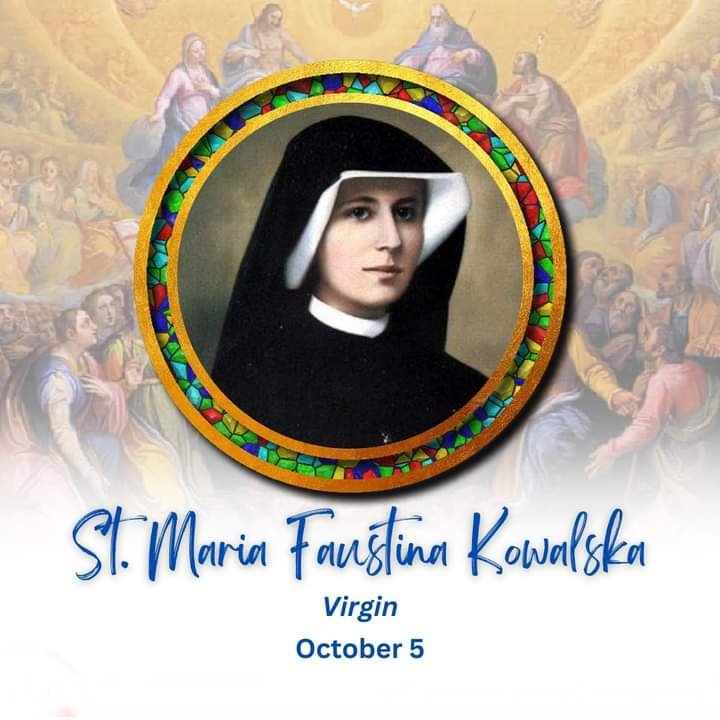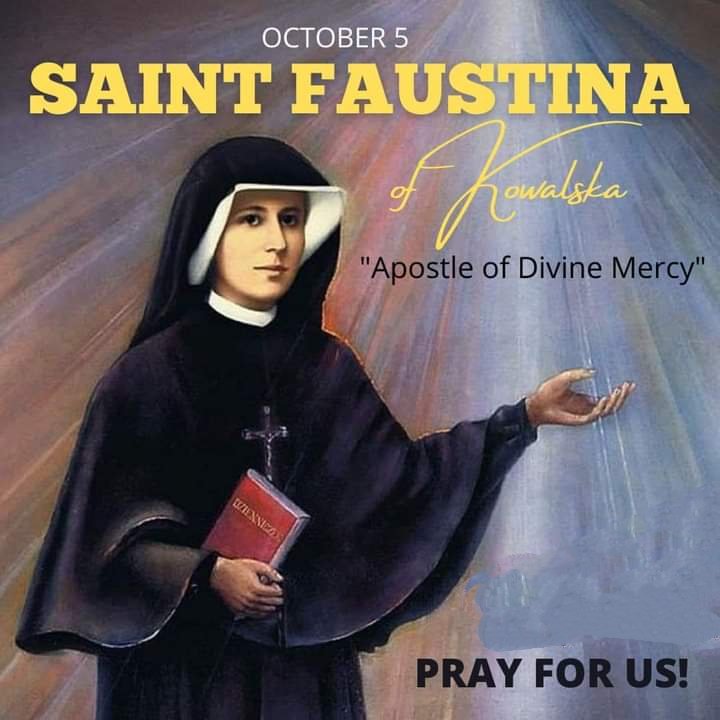
FEAST OF SAINT MARIA FAUSTINA KOWALSKA, APOSTLE OF DIVINE MERCY
FEAST DAY – 5th OCTOBER

Maria Faustyna Kowalska (born Helena Kowalska; 25 August 1905 – 5 October 1938, also known as Saint Maria Faustyna Kowalska of the Blessed Sacrament and popularly spelled Faustina, was a Polish Roman Catholic nun and mystic. Her apparitions of Jesus Christ inspired the Roman Catholic devotion to the Divine Mercy and earned her the title of “Secretary of Divine Mercy”.
Throughout her life, Kowalska reported having visions of Jesus and conversations with him, which she noted in her diary, later published as The Diary of Saint Maria Faustina Kowalska: Divine Mercy in My Soul. Her biography, submitted to the Congregation for the Causes of Saints, quoted some of the conversations with Jesus regarding the Divine Mercy devotion.
At the age of 20 years, she joined a convent in Warsaw. She was later transferred to Płock and then to Vilnius, where she met Father Michał Sopoćko, who was to be her confessor and spiritual director, and who supported her devotion to the Divine Mercy. With this priest’s help, Kowalska commissioned an artist to paint the first Divine Mercy image, based on her vision of Jesus. Father Sopoćko celebrated Mass in the presence of this painting on Low Sunday, also known as the Second Sunday of Easter or (as established by Pope John Paul II), Divine Mercy Sunday.

The Catholic Church canonized Kowalska as a saint on 30 April 2000. The mystic is classified in the liturgy as a virgin and is venerated within the church as the “Apostle of Divine Mercy”. Her tomb is in Divine Sanctuary, Kraków-Łagiewniki, where she spent the end of her life and met confessor Józef Andrasz, who also supported the message of mercy.
In 1924, at the age of 18 and a half, Kowalska went with her sister Natalia to a dance in a park in Łódź. Kowalska said that at the dance, she had a vision of a suffering Jesus, who she believed asked her: ‘How long shall I put up with you and how long will you keep putting Me off?” She then went to the Łódź Cathedral, where, as she later said, Jesus instructed her to depart for Warsaw immediately and to enter a convent. She took a train for Warsaw, without her parents’ permission, even though she knew nobody in Warsaw.
The girl approached several convents in Warsaw but was turned down each time, in one case being told that “we do not accept maids here”, a reference to her evident poverty. Kowalska could read and write and had three or four years of education. After several weeks of searching, the Mother Superior at the convent of Zgromadzenie Sióstr Matki Bożej Miłosierdzia (Congregation of the Sisters of Our Lady of Mercy) decided to give Kowalska a chance and accepted her under the condition that she pay for her religious habit.

Kowalska knew nothing of the convent that she was entering except that she believed she was being led there. In 1925, Kowalska worked as a housemaid to save the money she needed, making deposits at the convent throughout the year and was finally accepted, as the Mother Superior had promised. On 30 April 1926, at the age of 20 years, she was clothed in the habit and received the religious name of Sister Maria Faustina of the Blessed Sacrament.
In April 1928, having completed the novitiate, she took her first religious vows as a nun, with her parents attending the rite. She was to be a nun for the rest of her short life.
From February to April 1929, she was posted to the convent in Wilno, then in Poland, now known as Vilnius, the capital of Lithuania, where she served as a cook. Although her first posting to Vilnius was short, she returned there later and met the priest Michael Sopoćko, who supported her mission.

A year after her first return from Vilnius, in May 1930, she was transferred to the convent in Płock, Poland, for almost two years. It was while assigned to Vilnius that Kowalska was advised by her confessor, Michael Sopoćko, to keep a diary and record her apparitions. Faustina’s diary is the only mystical text composed in Polish.
The handwritten pages of Kowalska’s diary turned into about 700 printed pages, published as the book Diary: Divine Mercy in My Soul. It reflects her thoughts, prayers and reported visions and conversations with Jesus on Divine Mercy.
Kowalska’s Vatican biography quotes some of her reported conversations with Jesus from her diary. In March 1959, the Holy Office issued a notification, signed by Hugh O’Flaherty as notary, that forbade circulation of “images and writings that promote devotion to Divine Mercy in the forms proposed by Sister Faustina” (emphasis in the original).

Since at least 2002, it is claimed the negative judgement of the Holy Office was based on misunderstanding due to the latter’s use of a faulty French or Italian translation of the diary. However, at the time, the ban was due to “serious theological reservations and what Vatican evaluators felt to be an excessive focus on Faustina herself.”
The ban on her work remained in place for almost two decades, but was reversed in 1978. On 15 April 1978, the Congregation for the Doctrine of the Faith issued a new notification that rescinded the previous one and reversed the ban on circulation of Kowalska’s work. It decreed: “This Sacred Congregation, in view of the many original documents that were unknown in 1959, giving consideration to the profoundly changed circumstances, and taking into account the view of many Polish ordinaries, declares no longer binding the prohibitions contained in the cited ‘notification'”.
Kowalska arrived in Płock in May 1930. That year, the first signs of her illness, which was later thought to be tuberculosis, appeared, and she was sent to rest for several months in a nearby farm owned by her religious order. After her recovery, she returned to the convent, and by February 1931, she had been in the Płock area for about nine months. Kowalska wrote that on the night of Sunday, 22 February 1931, while she was in her cell in Płock, Jesus appeared wearing a white garment with red and pale rays emanating from his heart. In her diary (Notebook I, Items 47 and 48), she wrote that Jesus told her:

Paint an image according to the pattern you see, with the signature: “Jesus, I trust in You” (in Polish: “Jezu, ufam Tobie”). I desire that this image be venerated, first in your chapel, and then throughout the world. I promise that the soul that will venerate this image will not perish. Not knowing how to paint, Kowalska approached some other nuns at the convent in Płock for help, but she received no assistance. Three years later, after her assignment to Vilnius, the first artistic rendering of the image was produced under her direction.
In the same 22 February 1931 message about the Divine Mercy image, as Kowalska also wrote in her diary (Notebook I, item 49), Jesus told her that he wanted the Divine Mercy image to be “solemnly blessed on the first Sunday after Easter Sunday; that Sunday is to be the Feast of Mercy.” In November 1932, Kowalska returned to Warsaw to prepare to take her final vows as a nun, by which she would become in perpetuity a sister of Our Lady of Mercy. The ceremony took place on 1 May 1933.
In late May 1933, Kowalska was transferred to Vilnius to work as the gardener; her tasks including growing vegetables. She remained in Vilnius for about three years, until March 1936. Shortly after arriving in Vilnius, Kowalska met the priest Michael Sopoćko, the newly appointed confessor to the nuns. He was also a professor of pastoral theology at Stefan Batory University, now called Vilnius University.

When Kowalska went for the first time to this priest for confession, she told him that she had been conversing with Jesus, who had a plan for her. After some time, Sopoćko insisted on a complete psychiatric evaluation of Kowalska by Helena Maciejewska, a psychiatrist and a physician associated with the convent. This took place in 1933 and Kowalska passed the required tests and was declared of sound mind.
Sopoćko then began to have confidence in Kowalska and supported her efforts. Kowalska told Sopoćko about the Divine Mercy image, and in January 1934, Sopoćko introduced her to the artist Eugene Kazimierowski, who was also a professor at the university.
By June 1934, Kazimierowski had finished painting the image, based on the direction of Kowalska and Sopoćko, the only Divine Mercy painting that Kowalska saw. According to Catholic author Urszula Gregorczyk, a superimposition of the face of Jesus in the Image of the Divine Mercy upon that in the already-famous Shroud of Turin shows great similarity.

Kowalska wrote in her diary (Notebook I, Item 414) that on Good Friday, 19 April 1935, Jesus told her that he wanted the Divine Mercy image to be publicly honoured. A week later, on 26 April 1935, Sopoćko delivered the first sermon ever on the Divine Mercy, and Kowalska attended the sermon. The first Mass during which the Divine Mercy image was displayed occurred on 28 April 1935, the second Sunday of Easter, and was attended by Kowalska. It was also the celebration of the end of the Jubilee of the Redemption by Pope Pius XI.
On 13 September 1935, while still in Vilnius, Kowalska wrote of a vision about the Chaplet of Divine Mercy in her diary (Notebook I, Item 476). The chaplet is about a third of the length of the Rosary. Kowalska wrote that the purpose for the chaplet’s prayers for mercy is threefold: to obtain mercy, to trust in Christ’s mercy, and to show mercy to others.
In November 1935, Kowalska wrote the rules for a new contemplative religious congregation devoted to the Divine Mercy. In December, she visited a house in Vilnius that she said she had seen in a vision as the first convent for the congregation.

In January 1936, Kowalska went to see Jałbrzykowski to discuss a new congregation for Divine Mercy. However, he reminded her that she was perpetually vowed to her current order. In March 1936, Kowalska told her superiors that she was thinking of leaving the order to start a new one.
She intended to start one that was specifically devoted to Divine Mercy, but she was transferred to Walendów, southwest of Warsaw. She reported that Jesus had said to her: “My Daughter, do whatever is within your power to spread devotion to My Divine Mercy, I will make up for what you lack.”
Later in 1936, Faustina became ill with what has since been speculated to be tuberculosis. She was moved to the sanatorium in Prądnik, Kraków. She continued to spend much time in prayer in reciting the chaplet and praying for the conversion of sinners. The last two years of her life were spent praying and keeping her diary.

On 23 March 1937, Kowalska wrote in her diary (Notebook III, Item 1044) that she had a vision that the feast of the Divine Mercy would be celebrated in her local chapel and would be attended by large crowds and also that the same celebration would be held in Rome, attended by the pope.
In July 1937, the first holy cards with the Divine Mercy image were printed. In August, Sopoćko asked Kowalska to write the instructions for the Novena of Divine Mercy, which she had reported as a message from Jesus on Good Friday 1937.
Throughout 1937, progress was made in promoting the Divine Mercy, and in November 1937, a pamphlet was published with the title Christ, King of Mercy. The pamphlet included the chaplet, the novena and the litany of the Divine Mercy.
The Divine Mercy image appeared on the cover, with the signature “Jesus I Trust in You”. On 10 November 1937, Mother Irene, Kowalska’s superior, showed her the booklets while Kowalska rested in her bed.

As her health deteriorated at the end of 1937, Kowalska’s reported visions intensified, and she was said to be looking forward to an end to her life. In April 1938, her illness had progressed, and she was sent to rest in the sanatorium in Prądnik for what was to be her final stay there. In September 1938, Sopoćko visited her at the sanatorium and found her very ill but in ecstasy, as she was praying. Later that month, she was taken back home to Kraków to await her death there. Sopoćko visited her at the convent for the last time on 26 September 1938.
Kowalska died at the age of 33, on 5 October 1938, in Kraków. She was buried on 7 October and now rests at Kraków’s Basilica of Divine Mercy. Before her death, Kowalska predicted that “there will be a war, a terrible, terrible war” and asked the nuns to pray for Poland.
In 1939, a year after Kowalska’s death, Romuald Jałbrzykowski noticed that her predictions about the war had taken place and allowed public access to the Divine Mercy image, which resulted in large crowds that led to the spread of the Divine Mercy devotion.

The devotion became a source of strength and inspiration for many people in Poland. By 1941, the devotion had reached the United States, and millions of copies of Divine Mercy prayer cards had been printed and distributed worldwide. In 1942, Jałbrzykowski was arrested by the Nazis, and Sopoćko and other professors went into hiding near Vilnius for about two years. During that period, Sopoćko used his time to prepare for the establishment of a new religious congregation, based on the Divine Mercy messages reported by Kowalska.
After the war, Sopoćko wrote the constitution for the congregation and helped the formation of what is now the Congregation of the Sisters of the Divine Mercy. By 1951, 13 years after Kowalska’s death, there were 150 Divine Mercy centers in Poland. On 24 June 1956, Pope Pius XII blessed an Image of the Divine Mercy in Rome, the only one blessed by a pope before the Second Vatican Council.
In 1955, under Pope Pius XII, the Bishop of Gorzów founded a religious order, the Congregation of the Most Holy Lord Jesus Christ, Merciful Redeemer, to spread devotion to the Divine Mercy. Under both Pope Pius XI and Pope Pius XII, writings on devotion to the Divine Mercy were given imprimaturs by many bishops, making it an approved devotion. Cardinals Adam Stefan Sapieha and August Hlond were among those who gave their approval. During the papacy of Pope Pius XII, Vatican Radio broadcast several times about the Divine Mercy.
Archbishop Karol Wojtyła later became Pope John Paul II and beatified and canonized Kowalska. He died in April 2005, on the eve of Divine Mercy Sunday, and was himself beatified by his successor, Pope Benedict XVI, on Divine Mercy Sunday, 1 May 2011, and was canonized by Pope Francis on Divine Mercy Sunday, 27 April 2014. Divine Mercy Sunday is celebrated on the Second Sunday of Easter, the Sunday after Easter Sunday.

In 1965, with the approval of the Holy Office, Karol Wojtyła, then Archbishop of Kraków and later Pope John Paul II, opened the initial informative process into Kowalska’s life and virtues, and interviewed witnesses.
In 1967, he submitted a number of documents about Kowalska to the Vatican and requested the start of the official process of her beatification. That was begun in 1968 and concluded with her beatification on 18 April 1993. She was canonised on 30 April 2000, and her feast day is 5 October.
The Holy See’s Press Office biography provided on the occasion of her canonization quotes some of her reputed conversations with Jesus.[2] The author and priest Benedict Groeschel considers a modest estimate of the following of the Divine Mercy devotion in 2010 to be over 100 million Catholics. In October 2011, a group of cardinals and bishops sent a petition to Pope Benedict XVI for Kowalska to be made a Doctor of the Church.

On the 100th anniversary of the birth of Pope John Paul II, 18 May 2020, Faustina was added by Pope Francis to the General Roman Calendar as an optional memorial.
The decree, issued by the Congregation for Divine Worship and the Discipline of the Sacraments, allows her memorial to be celebrated around the world during Mass and the Liturgy of the Hours.
The formal beatification of Kowalska involved the case of Maureen Digan of Massachusetts.[55] In March 1981 Digan reported a healing, while she was praying at the tomb of Kowalska.[32] Digan had suffered from lymphedema, a disease that causes significant swelling from fluid retention, for decades and had undergone ten operations, including a leg amputation. Digan reported that while she prayed at Kowalska’s tomb, she heard a voice saying “ask for my help and I will help you”, and her constant pain stopped.

Prayer to Saint Faustina by the Holy Father John Paul II
And you, Faustina, a gift of God to our time, a gift from the land of Poland to the whole Church, obtain for us an awareness of the depth of Divine Mercy; help us to have a living experience of it and to bear witness to it among our brothers and sisters. May your message of light and hope spread throughout the world, spurring sinners to conversion, calming rivalries and hatred, and opening individuals and nations to the practice of brotherhood. Today, fixing our gaze with you on the Face of the Risen Christ, let us make our own your prayer of trusting abandonement and say with firm hope:”Jesus, I trust in You!”.
Saint Faustina’s prayer for healing
Jesus, may Your pure and healthy blood circulate in my ailing organism, and may Your pure and healthy body transform my weak unhealthy body, and may a healthy and vigorous life flow within me, if it is truly Your Holy Will. Amen

PRAYER
Dear Lord Jesus, you have blessed us with your comforting presence, full of Mercy, whenever we call upon you for your unfailing help. You lavishly shower Mercy and love upon us, just as you showed and revealed your message of Mercy to St. Faustina, a simple nun from Poland.
You revealed that souls who make appeal to your Mercy are granted even more graces than they ask, and receive your great compassion in which they dwell in comfort.
In great consolation and peace, we are inspired by the life of prayer of Saint Faustina, who offered up prayers of trust in your Mercy, to become a channel of your Mercy to the world.
We trust in your Divine Providence and appeal to you to show us your Mercy in the midst of our troubles and trials. Amen







